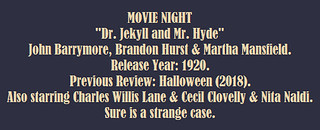
Review #1152: Dr. Jekyll and Mr. Hyde.
Cast:
John Barrymore (Dr. Henry Jekyll / Mr. Edward Hyde), Brandon Hurst (Sir George Carewe), Martha Mansfield (Millicent Carewe), Charles Willis Lane (Dr. Richard Lanyon), Cecil Clovelly (Edward Enfield), Nita Naldi (Miss Gina), and Louis Wolheim (Dance Hall proprietor) Directed by John S. Robertson.
Review:
It is always interesting to look deep into the past for films, particularly with horror movies. 1920 was a particularly interesting year for horror, with this film being released alongside other horror films such as The Cabinet of Dr. Caligari and The Golem: How He Came into the World. In any case, this film is a pretty effective one that is worth a look for horror fans, particularly ones into silent features with a standout lead performance. The credits list Clara Beranger as providing the scenario for the film, which took inspiration from the stage play adaptation by Thomas Russell Sullivan that had first opened in 1887, the year after the publishing of the original novella by Robert Louis Stevenson. The changes from the novella for the stage play are reflected here in the film, such as giving Jekyll a fiancee and making more of a contrast between him and Hyde in their morals. This was the fourth adaptation of the work into film (the other three being done in 1908, 1912, and 1913, respectively), along with the first of three adaptations released in 1920, with one being directed by F. W. Murnau, although his film, The Head of Janus, is now lost. Barrymore shines above the rest of the cast, managing to play both roles with a clear distinction through his expressions that make for some fairly compelling drama with him. Hurst does pretty good as the counterpart to play against Barrymore for certain scenes, presenting a somewhat compelling argument for yielding to temptation in order to combat it. The other cast members aren't too bad, but the real focus stays on its star for the chunk of its 79 minute run-time, and it never really borders on boredom at any main point.
The struggle between trying to separate evil impulse and the soul is certainly something that can be worth thinking about for time after a viewing of something nearly a century old. The film takes its time to build to its big highlight - the transformation of Jekyll to Hyde. This is where Barrymore shines the most, as this was a scene without any sort of special makeup or camera tricks, being one long sequence where he turns away from the camera by hiding his face with his hands to later reveal his features of the beast, complete with face contortions from Barrymore. Of course in later sequences there is makeup used to show a pointy head and fangs, but they are well-done for the time. The Hyde sequences certainly must have proved a bit shocking for its time, adding to the entertainment factor fairly well. The climax delivers a fair and quick payoff, and on the whole the movie is a fairly entertaining one, with Barrymore being the key highlight that makes this one worth a watch nearly a century since its release.
Overall, I give it 8 out of 10 stars.

No comments:
Post a Comment